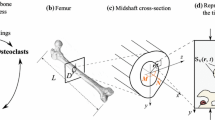Abstract
Progression of osteoporosis is caused by a decline in bone formation activity relative to the resorption activity. In this paper, the authors carried out a theoretical analysis of the progression of osteoporosis to estimate the osteoporotic change in the upper end of the femur. According to this analysis, the progression rate of osteoporosis in cancellous bone depends on the product of remodeling activity,R act, and the trabecular structure parameter,K tr. To confirm that the theoretical results were reasonably comparable to actual osteoporotic change, these two factors were measured in rabbits. From the results, it was concluded that the highest progression rate was shown in bar/barlike trabecular structure (type 3); the next highest rate, was shown in plate/bar-like structure (type 2); and the plate/plate-like structure (type 1) was the most insensible. Furthermore, the bone volume fractions of cancellous bone were measured at the upper end of human femurs with and without osteoporosis. Then the measured value was compared with the theoretical value for each type of trabecular structure. Results showed that the decrease in bone volume fraction predicted by Eq. 7 was well in accord with the actual decrease.
Similar content being viewed by others
References
Avioli, L. V. Osteoporosis, Metabolic Bone Disease. New York: Academic Press, 1977.
Carter, D. R., D. P. Fyhrie, and R. T. Whalen. Trabecular bone density and loading history: regulation of connective tissue biology by mechanical energy.J. Biomech. 20:785–794, 1987.
Cowin, S. C., and D. H. Hegedus. Bone remodeling. I: Theory of adaptive elasticity.J. Elasticity 6:313–326, 1976.
Frost, H. M. Tetracycline labeling of bone and the zone of demarcation of osteoid seam.J. Biochem. Physiol. 40:485–489, 1962.
Frost, H. M. Measurement of human bone formation by means of tetracycline labeling.Can. J. Biochem. Physiol. 41:31–42, 1963.
Frost, H. M. Bone dynamics in metabolic bone disease.J. Bone Joint Surg. 48-A:1192–1203, 1966.
Gibson, L. J. The mechanical behavior of cancellous bone.J. Biomech. 18:317–328, 1985.
Hart, R. T., D. T. Davy, and K. G. Heiple. Mathematical modeling and numerical solutions for functionally dependent bone remodeling.Calcif. Tissue Int. 36:S104–S109, 1984.
Huiskes, R. Adaptive bone-remodeling analysis.Chir. Org. Mov. LXXVII,II:121–133, 1992.
Kock, J. C. The laws of bone architecture.Am. J. Anat. 21:177, 1917.
Milch, R. A., D. P. Rall, and J. E. Toble. Bone localization of the tetracycline.J. Natl. Cancer Inst. 19:87–93, 1957.
Morita, M., N. Sasamoto, M. Yamamoto, and T. Sasada. Mechanical properties of cancellous bone and its trabecular structure. Proc. 26th Jpn. Cong. Mater. Res., 1983, 233–240.
Rice, J. C., S. C. Cowin and J. A. Bowman. On the dependency of the elasticity and strength of cancellous bone on apparent density.J. Biomech. 21:155–168, 1988.
Richardson, S. P., A. Winck, and J. Black. Mechanical behavior of osteoporotic bone structural approach.Trans. Orthop. Res. Soc. 11:462, 1986.
Shing, M., A. R. Nagrath, and P. S. Maini. Changes in trabecular pattern of upper end of the femur as an index of osteoporosis.J. Bone Joint Surg. 52-A: 457–467, 1970.
Takahashi, H., and H. M. Frost. A tetracycline based comparison of the number of cortical bone forming sites in normal and diabetic persons.J. Jpn. Orthop. Assoc. 39:1115–1121, 1966.
Turner, C. H. On Wolff’s law of trabecular architecture.J. Biomech. 25:1–9, 1992.
Underwood, E. E. Quantitative Stereology, chapter 3. Reading, Massachusetts: Addison-Wesley, 1965.
Wolff, J. Uber die innere Architektur der Knechen und Bedeutung fur die Frage vom Knochenwachstum.Virchows Arch. Pathol. Anat. 50:389, 1870.
Author information
Authors and Affiliations
Rights and permissions
About this article
Cite this article
Morita, M., Ebihara, A., Itoman, M. et al. Progression of osteoporosis in cancellous bone depending on trabecular structure. Ann Biomed Eng 22, 532–539 (1994). https://doi.org/10.1007/BF02367089
Received:
Revised:
Accepted:
Issue Date:
DOI: https://doi.org/10.1007/BF02367089




